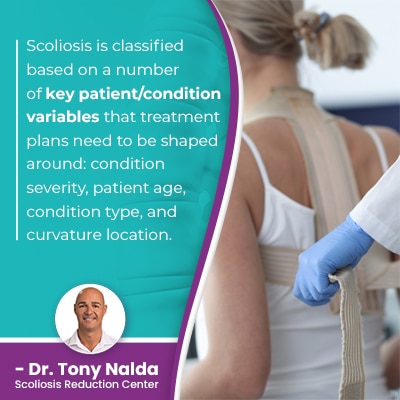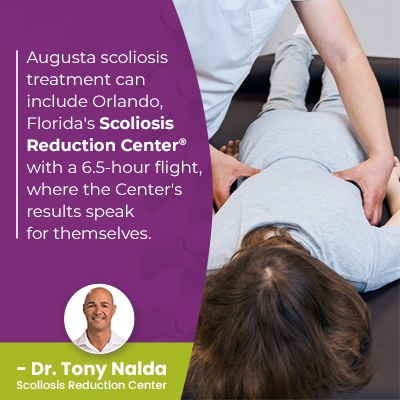Augusta Scoliosis Treatment: Non-Surgical Solutions

There are a number of spinal conditions that cause a loss of its healthy curves, and what's most important is how a diagnosis is responded to. When it comes to progressive conditions like scoliosis, as the condition is virtually guaranteed to get worse over time without treatment, being proactive with treatment is key.
With a 6.5-hour flight, Augusta scoliosis patients can access Dr. Tony Nalda's non-surgical treatment for scoliosis at his Orlando practice. The Scoliosis Reduction Center® can provide support and conservative treatment options for all types and severity levels of scoliosis.
Scoliosis treatment options are important because no two cases are the same and treatment plans need to be customized.
Table of Contents
Diagnosing Scoliosis
Diagnosing scoliosis means a progressive spinal condition has developed that causes the spine to bend to the side and twist.
The rotational component makes scoliosis a 3-dimensional condition, and the condition ranges widely in severity.
When scoliosis is first diagnosed, part of the process involves comprehensively assessing conditions and classifying them accordingly.
 Scoliosis is classified based on a number of key patient/condition variables that treatment plans need to be shaped around: condition severity, patient age, condition type, and curvature location.
Scoliosis is classified based on a number of key patient/condition variables that treatment plans need to be shaped around: condition severity, patient age, condition type, and curvature location.
A diagnosis is reached through a comprehensive physical examination that often includes an adams forward bend test and X-ray results.
An X-ray is needed to confirm the rotational component and a patient's Cobb angle; rotation has to be present and a minimum Cobb angle of 10 degrees is needed to be diagnosed as scoliosis and to determine condition severity.
Here at the Center, Augusta scoliosis patients can benefit from an individualized approach designed by Dr. Tony Nalda, renowned scoliosis chiropractor.
Condition Severity
Scoliosis ranges from mild to moderate scoliosis and severe to very severe, and this is determined by a patient's Cobb angle measurement.
The measurement is determined by drawing lines from the tops and bottoms of the curve's most-tilted vertebrae, and the resulting angle is expressed in degrees; the higher the degree, the more severe the condition.
The more severe scoliosis is, the further out of alignment the spine is, and the more problematic the condition can become.
While every case is unique, as a progressive condition, most cases will get worse over time, particularly without treatment, or if not treated proactively.
Mild scoliosis is diagnosed with a Cobb angle measurement of between 10 and 25 degrees
Moderate scoliosis involves measurements of between 25 and 40 degrees
Severe scoliosis is diagnosed at 40+ degrees and very-severe scoliosis at 80+ degrees
Condition severity also indicates the types of symptoms a patient will experience; the milder scoliosis is, the more subtle its effects will be, and if progression occurs, its effects will become more noticeable.
While there are never treatment guarantees, there are fewer limits to what can be achieved with non-surgical treatment when early detection and intervention are achieved.
Patient Age
Patient age is important because scoliosis affects all ages, and the condition affects different age groups in different ways.
When it comes to progression, we know it's triggered by growth, which is why childhood scoliosis should always be taken seriously.
Growth spurts trigger progression, and the more growth a patient has to go through means the more potential progression they can face.
Scoliosis can affect babies born with the condition as congenital scoliosis, infants between the ages of 6 months and 3 years developing infantile scoliosis, juvenile scoliosis diagnosed between 3 and 10, and adolescent idiopathic scoliosis is the most prevalent type diagnosed between the ages of 10 and reaching skeletal maturity.
Adult scoliosis is diagnosed once skeletal maturity is reached, and degenerative changes in the spine that affect older adults can involve degenerative scoliosis affecting adults over the age of 50.
Patient age is also an indicator of how painful a condition is likely to be; scoliosis becomes a compressive condition once skeletal maturity has been reached.
Compression is uneven pressure and is the main cause of condition-related pain. Growing spines are constantly being lengthened, which counteracts the compressive force of the unnatural spinal curve.
So children don't commonly experience a lot of back pain and nerve pain, but pain is the main symptom of adult scoliosis.
Condition Type
Condition type is determined by a condition's underlying cause, and this classifies conditions by type: idiopathic scoliosis, neuromuscular scoliosis, degenerative scoliosis, and congenital scoliosis.
Idiopathic scoliosis is the most common type to affect all ages, and idiopathic scoliosis has no known cause, and this accounts for approximately 80 percent of known diagnosed cases.
The remaining 20 percent are associated with known causes, and this includes neuromuscular, degenerative, and congenital scoliosis.
Neuromuscular scoliosis is caused by the presence of larger neuromuscular conditions like spina bifida, muscular dystrophy, and cerebral palsy.
With cases of NMS, the larger neuromuscular condition has to be the focus of treatment, which complicates the process.
Degenerative scoliosis is caused by natural age-related spinal degeneration and the cumulative effect of certain lifestyle factors: carrying excess weight, chronic poor posture, low activity levels, repeatedly lifting heavy objects incorrectly, and excessive consumption of alcohol and/or smoking.
Congenital scoliosis is caused by a malformed spine that develops in utero.
Curvature Location
There are three main spinal sections, and scoliosis can develop in any, or in more than one as a combined scoliosis.
The cervical spine includes the neck, and the thoracic spine is the largest section including the middle and upper back, and the lumbar spine includes the lower back.
Curvature location is important not just to determine where to concentrate treatment efforts, but also because curvature location can indicate particular symptoms; in most cases, the area of the body located the closest to an affected spinal section is the most likely to feel its direct effects.
For example, cases of lumbar scoliosis are associated with sciatic nerve pain.
The sciatic nerve starts in the lower back, so if the lumbar spine is unnaturally curved and compressed, the sciatic nerve can become compressed and irritated anywhere along its extensive pathway.
Scoliosis Treatment Options
Scoliosis treatment is an important decision because there are two very different treatment options for scoliosis: surgical or non-surgical.
Non surgical treatments are less invasive and safer than a surgical procedure. Scoliosis surgery is a type of spinal fusion that can cost the spine in strength and spinal mobility and flexibility.
Surgical treatment is traditional and doesn't have a strategy for addressing scoliosis while mild, which is when it's most likely to respond well.
Modern conservative treatment and non surgical treatment options are proactive and started as close to the time of diagnosis as possible because smaller curves are simpler to treat, and once progression occurs, the spine is becoming increasingly rigid, making it less responsive to treatment, and also difficult for some patients to perform key therapeutic exercises as part of treatment.
The goal of conservative treatment is to prevent progression, and advanced techniques in chiropractic care, physical therapy, and corrective bracing can help many patients avoid the potential complications of surgery.
Conservative treatment is minimally invasive and better for spinal strength, health, and function. A treatment plan that's fully customized and integrative can impact scoliosis on every level; while severe cases can require surgical treatment, the reality is that many cases of scoliosis don't require spinal fusion surgery, particularly with early detection and intervention.
Conclusion
 Augusta scoliosis treatment can include Orlando, Florida's Scoliosis Reduction Center® with a 6.5-hour flight, where the Center's results speak for themselves.
Augusta scoliosis treatment can include Orlando, Florida's Scoliosis Reduction Center® with a 6.5-hour flight, where the Center's results speak for themselves.
Conservative non-surgical scoliosis treatment is what the Center offers patients, and because Dr. Tony is trained, certified, and experienced in a number of scoliosis-specific disciplines, patients benefit from accessing these different types of treatment under one roof.
An integrative approach is what the condition needs because no one treatment discipline is enough to impact the condition on every level, but conservative treatment combines chiropractic care, physical therapy, corrective bracing, scoliosis exercises, and rehabilitation.
Chiropractic care can work towards realigning the spine and restoring as much of its healthy curves as possible, and scoliosis exercises and physical therapy can be applied to improve the spine's surrounding muscle strength and balance, improve posture, and activate certain areas of the spine for improved brain-body communication.
Corrective bracing is a regular facet of childhood scoliosis and can augment corrective treatment results by pushing the spine into a corrective position.
Rehabilitation is about holding treatment results, and this can involve lifestyle guidance, continued chiropractic care, and the prescription of scoliosis-specific exercises.
Remember, scoliosis treatment is about how best to manage an ongoing condition for the best quality of life, and this is what makes traveling to become a patient of the Scoliosis Reduction Center® worth it.
Dr. Tony Nalda
DOCTOR OF CHIROPRACTIC
After receiving an undergraduate degree in psychology and his Doctorate of Chiropractic from Life University, Dr. Nalda settled in Celebration, Florida and proceeded to build one of Central Florida’s most successful chiropractic clinics.
His experience with patients suffering from scoliosis, and the confusion and frustration they faced, led him to seek a specialty in scoliosis care. In 2006 he completed his Intensive Care Certification from CLEAR Institute, a leading scoliosis educational and certification center.
About Dr. Tony Nalda
 Ready to explore scoliosis treatment? Contact Us Now
Ready to explore scoliosis treatment? Contact Us Now





